Organ at Risk Segmentation for Head and Neck Cancer using Stratified Learning and Neural Architecture Search
abstract
Risk organ( OAR)The division is the head and neck( H&N)Key steps in cancer radiotherapy, inconsistencies among radiation oncologists and high labor costs drive automated methods. However, leading methods using standard full convolution network workflow are challenged when the number of oars increases, for example, OAR When the number is more than 40, for this case, it can be manually clinical OAR The authors propose Hierarchical Risk organ segmentation( SOARS)Model, this is a kind of OAR Divided into anchor,mid_level and small&hard(S&H)Method of category. SOARS Layered on two dimensions. The first dimension is each OAR Categories use different processing frameworks. In particular, inspired by clinical practice, anchor Used to guide intermediate and S&H Category. The second dimension is to use different network architectures to manage different OAR Significant contrast, size, and anatomical differences between. The authors used a microneural structure search( NAS),Allow network access at 2 D,3D Or pseudo 3 D Select from convolution.142 h&N Extensive 4-fold cross validation was performed in 42 cancer patients, of which 42 were manually labeled OAR,This is by far the most comprehensive OAR Data sets that show the framework and NAS Layering significantly improves state-of-the-art quantitative performance( Dice Absolute score from 70.44%Increased to 75.14%). So, SOARS Provides a powerful and principled approach to managing highly complex OAR Split space.
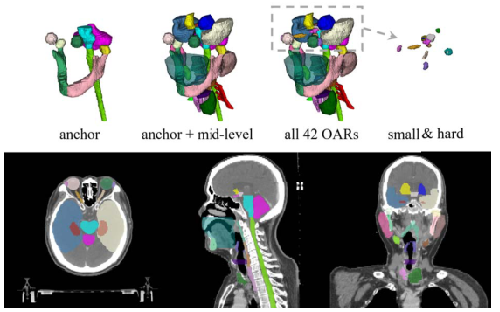

Structured learning and neural architecture search model
The author uses different layers to learn and segment different classified organs anchor For guidance, mid_level,and small&hard Split (first dimension) and use Neural Architecture Search(NAS),For backbone network PHNN Search for different convolution modules to obtain higher segmentation accuracy and robustness.
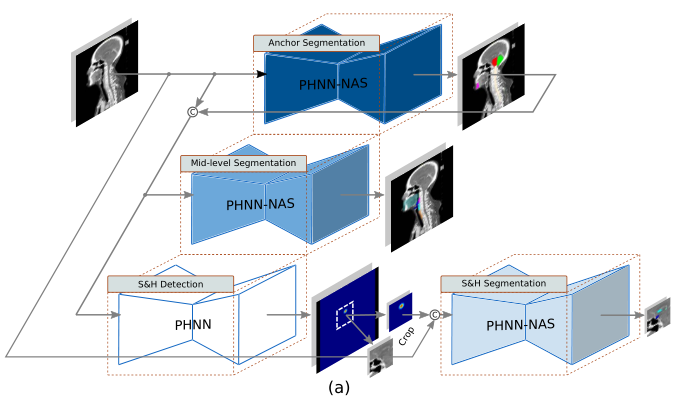
Hierarchical learning: hierarchical learning is an effective strategy to decompose complex tasks into simpler single subtasks. In medical imaging, hierarchical statistical learning is also used to identify whether candidate nodules are connected to any other major lung anatomical structures. However, the application of hierarchical learning in semantic segmentation, especially in the era of deep learning, is still relatively lack of research in medical imaging The operator is the first to perform hierarchical learning for deep high-risk organ segmentation. Neural network search: modern deep neural networks sometimes contain many types of layers, and these layers are more than one. Skip connections At present, most deep neural network structures are established based on human experience, which requires a long and cumbersome trial. NAS Try to detect an effective architecture for specific deep learning problems without human intervention. Generally speaking, NAS It can be divided into three dimensions - search space, search strategy and performance evaluation strategy. NAS A deeper neural network architecture is successfully established, and its accuracy exceeds that of the manually constructed structure. Using evolutionary algorithm and reinforcement learning, especially in the field of image classification tasks, NAS The latest architecture generated has been developed. This method is expensive because in NAS Before producing successful results, hundreds of specific deep neural networks need to be trained and tested. NAS Method is too expensive for most practical applications.
Backbone network PHNN
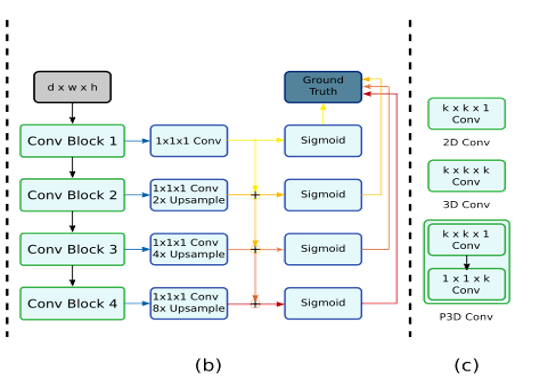
P-HNN is an abstract feature that can access higher levels at a deeper level, combines predictions from different network stages, and allows contributions of different levels and scales to get the final results. It is similar to FCN network, but the difference is that FCN network is a coarse to fine segmentation process, and PHNN is an evolutionary constraint to select multi-scale paths without Additional convolution layer or network parameters are required. It was originally proposed in pathological lung segmentation.
For figure C, these are three different convolution modules. The whole network is to try 2D conv, 3D conv and P3D conv (Pseudo 3D) respectively for the convolution modules in the backbone network under the search of NAS to obtain better segmentation accuracy.
For the anchor layer, we first specify the input of the network as set S

Here Xn is the CT image we input, YA refers to the image manually marked by anchor, YM refers to the manual mark of mid_level, and YN refers to the manual mark of small & hard.
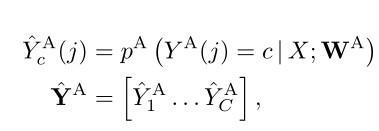
pA is the training function of our network model, c refers to the number of organs in anchor, and WA refers to the parameters of the model.
Y ^ is a result of network prediction. It is input into mid_level and small & hard at the same time to guide the segmentation of the other two layers.
Similarly, for mid_level

small&hard


Just for samll&hard Specifically, the author uses a thermal map regression method to detect the central region of the organ, in which 3 D Gaussian kernels create heat map labels at the center of each organ. Heat map regression: the general idea is to build a heat map according to the manually marked feature point coordinates. The heat map is the same size as the original map. In the heat map, the closer it is to the feature point, the larger the pixel value is; on the contrary, the smaller the pixel value is, and the feature points are similar to light spots in the heat map. The heat map constructed is CNN The label is equivalent to semantic segmentation ground-truth mask,Then let CNN The network goes back to this heat map.
result
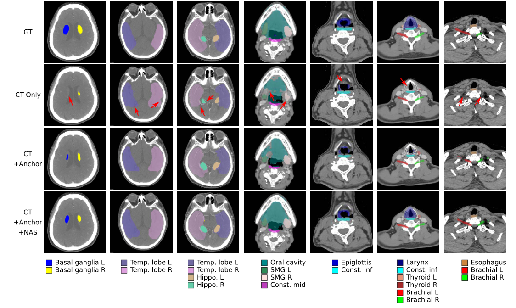

Performance on other data sets

It can be seen from the above that the method proposed by the author has achieved a certain degree of accuracy improvement on multiple data sets.
conclusion
This work proposes SOARS, a new framework that divides the H & n paddle into two dimensions. Inspired by clinical practice, we divide OAR into three categories: anchor, intermediate and S & H, and provide a customized processing framework for each category. Importantly, intermediate and S & H branches are based on more reliable prediction of anchor branches. In addition, we layer the network architecture and perform effective NAS for each architecture. We tested on the most comprehensive H & n dataset to date, which includes 42 different oars. Compared with SOTA method, the improvement of intermediate and S & H paddles is the most significant. With this, we proved that our proposed SOARS can surpass all the most advanced baseline networks, including the latest representative work UaNet, by 4%. It is 70% in DSC. Therefore, our work This is an important step towards reliable and automated H & n OAR segmentation.